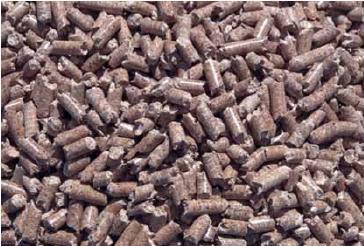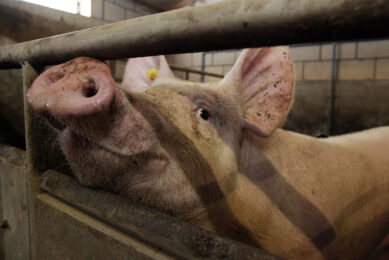How feed structure can improve animal health

The influence of feed structure on the health of the GI-tract in pigs has been extensively studied in recent years in Denmark and more recently in Germany (Hannover DBIS), among others to find a relationship between particle size and the prevention of Salmonella infections.
When comparing pelletised and mash feed with each other, the thermally treated (thus pelletised) feed obtains superior pig performance due to gelatinisation that takes place in the pelleting die. In addition the pressure and temperature during pelleting also form a perfect hygienisation stage. Up to 99% of the natural microbial flora is eliminated. Therefore in Denmark for years it was ruled that feeds for fattening pigs had to be heated to at least 81°C during the pelleting process, so that any Salmonella would be killed.
But does pelleted feed only have advantages? A pig will eat more from a pelleted feed in the same time than from a mash feed. Feed pellets require significantly more time to dissolve and thus the risk of insufficient feed acidification in the stomach arises. Mash feed in contrast is taken up in smaller portions during the day, is better insalivated and faster acidified in the stomach. Hansen (2004) demonstrated that a coarsely ground mash feed in the stomach reached pH2 in two hours, while administered as a pelleted feed (finely ground press meal) it took four hours to reach the same pH.
Effect of grinding
The influence of grinding (fine vs. coarse) of mash feed and for pelleted feed on Salmonella occurrence in finishing pigs was investigated in Denmark in several trials. In coarsely ground mash feed Salmonella detection was significantly reduced. And the use of coarsely ground meal for pellet feed production also led to a reduction in detection. However, it did not reach the same low level that was found in coarse ground mash feed.
The influence of grinding (fine vs. coarse) of mash feed and for pelleted feed on Salmonella occurrence in finishing pigs was investigated in Denmark in several trials. In coarsely ground mash feed Salmonella detection was significantly reduced. And the use of coarsely ground meal for pellet feed production also led to a reduction in detection. However, it did not reach the same low level that was found in coarse ground mash feed.
Also at the Institute of Animal Nutrition at the University of Veterinary Medicine in Hannover (Germany) several dissertations recently focused on the influence of feed structure (fine or coarsely ground) and acidification of feed and Salmonella occurrence in piglets and fatteners. In these works it was established that under experimental conditions and from field studies coarse grinding of feed in combination with the use of organic acids (or their salts) an adequate reduction of Salmonella contamination in piglet rearing and at finisher phase could be achieved.
When feed is ground coarser the following effects will occur: reduced passage rate in the stomach–> dry matter rate of stomach contents increases –>growth of lactic acid bacteria is promoted–> volume of dissociated lactic acid increases –>pH is reduced.
This leads to a significantly reduced ability of orally ingested Salmonella to survive in the environment. Jorgensen et al. (2000) also determined in experiments with pigs fed on mash that the concentration of acetic, butyric and propionic acid in the stomach was significantly higher than in pelleted feed – an additional “barrier effect” against Salmonella and other gram-negative bacteria. In this study the concentration of coliform bacteria in the stomach contents in the mash fed group were significantly reduced compared with the pellets fed group.
On the other hand, with coarsely ground feed a higher proportion of starch which cannot be digested and absorbed in the duodenum, reaches the caecum. The substrate thus favours the existing microflora in the ceacum, which degrade the starch to primarily propionic and butyric acid. These short-chain fatty acids limit the growth of Salmonella, which can lead to an overall reduction in Salmonella prevalence. Betscher (2010) found that feeding a coarse-textured mash feed to weaners significantly increased crypt depth in the caecum compared to the group fed pellets made of finely ground meal. Offenberg et al. (2007) report from their experiments on the performance parameters of pigs in the rearing and fattening phases that the generally feared loss in performance when using a coarsely ground mixed feed could not be confirmed. Especially in piglet rearing, daily gain and feed efficiency were indifferent between fine or coarse ground feeds.
Stomach ulcers
| Pellets usually give a better performance rate than a mix of the ingredients in meal form. However, also the meal used for the pellet needs a minimum particle size to avoid nutritional problems in pigs. |
Regarding the occurrence of gastric ulcers, according to studies of Groβe Liesner (2008), the maximisation of the coarse fraction of a feed is less important than the minimisation of the fines fraction (particles <0.4 mm). According to these studies the critical boundaries for fine particles <0.4 mm ranges from 20% (no mucosal damage) to 36% (already clearly detrimental to the mucous membrane). Betscher (2010) confirmed the impact of a greatly increased proportion of fine particles (compared coarsely ground meal feed using a 6 mm sieve, with pellets, ground with 1 mm sieve) on the incidence of hyperkeratotic changes in the epithelium of the pars non-glandularis (stomach entrance) in weaners.
Two other interesting aspects were identified in this study: the piglets that received the coarse ground mash feed on average had a 40.7% heavier gastric wall compared to the group fed pellets. The stomachs of the coarse ground mash fed group contained 27.1% significant higher dry matter content than the group fed fine ground pellets (16.7% DM).
Betscher (2010) concludes that the weight gain of the stomach is due to hypertrophy of the muscle layers, as with coarse meal these had to work harder to mix the mash and to transport it. In terms of performance parameters he found that the coarse mash fed piglets significantly ate more (+123 g per day) and with a tendency towards a better daily gain with 0.15 points showed a significantly worse FCR (1.89 vs. 1.74) than the pellet fed group.
For feeding practice the question occurs with what objective measureable parameters ‘coarse’ grinding can be defined. ‘Coarse ground’ marked experimental feeds in the various studies of the DBIS Hannover (piglet rearing and finisher) contained 35 to 54% of particles >1 mm (pelleted, crumbled and mash feeds). Base was the dry sieve analysis of the mealy feeds or wet sieving of pelleted or granulated feed (in some studies even with mash feed). Kamphues et al. (2008) gave as a benchmark for both dry and wet sieve fractioning of a minimum of 15 to 20% particles >1 mm.
Supporting the stomach barrier
Next to particle structure, viscosity of the feed is an important factor in digestion. Fledderus et al. (2007) used an experimental diet with increased viscosity by adding carboxymethylcellulose (CMC) to the feed and found a longer stay of the digesta in the stomach, an increased protein hydrolysis in the stomach, a significantly increased activity of aminopeptidase and a significantly improved protein digestibility. The authors see this as a good opportunity for weaning feeds to increase the nutritional value of feed and promote animal health (Table 1).
| Three feed structures in solution after 10 minutes. From left to right: 31% cooked grains (optigrain) included, 20% cooked grains, no cooked grains included in the pellet. |
The use of CMC in feed is not practical. However, viscosity of feed can be achieved by selecting components with a high concentration of non-starch polysaccharides (NSP) or heat treatment of feed and using more individual feed components. Although a higher viscosity of the digesta in the stomach is desirable, it is unwanted in the intestines. This excludes the increase of NSP in the feed, since these are not sufficiently broken down by enzymes and thus viscosity is not quickly lowered again. A very good way of a specific viscosity increase in piglet feeds is the use of cooked (expanded/extruded) cereals as a highly digestible source of starch. The viscosity change in cooked cereals is caused by structural changes in starch granules, as could be determined in comparative studies.
The increased viscosity of cooked mixtures of wheat, maize and barley was determined by using a starch breakdown degree greater than 70% (amyloglucosidase method, 15 min incubation at 50°C) using Brabender viscometer with and without addition of α-amylase. By adding α-amylase viscosity could be reduced significantly again (DTC, 2009). This viscosity effect of cooked grains can be specifically used to support the previously described processes in the stomach. The viscosity is directly reduced in the small intestine through the activity of the pancreas secreted α-amylase and thus has no influence in the gut anymore. Moreover, the uptake of such cooked grains at an inclusion rate of between 30 and 10% – depending on the feeding phase – result in a much faster dissolution of the feed in the stomach fluid. This can be practical explained by determining the dissolution behaviour of pelleted pig feed in water with different ratios of cooked grains in the mixture (31, 20 and 0%). Starch granules of cooked grains absorb water faster and thus create a greater swelling of the mix.Piglet feed with cooked grain will stay longer in suspension and thus deposit slower in liquid. This is another aspect that has a positive influence on the behaviour of the feed in the stomach of piglets and promotes acidification of the digesta. Besides that, in liquid feeding the better homogeneity has a positive effect on the stability of the feed mix when transported in the farm feeding system.
References are available on request.
Grinding Recommendations Extensive results of scientific investigations and practical experience in the feeding of sows, piglets and finisher pigs show that feed structure has a significant impact on all parameters in the GI-tract, which contribute to maintaining pig health. In the past, emphasis was put on digestibility of ingredients and feed conversion, but recent research shows that feed particle size also has great impact on the health of the GI-tract. Especially in critical phases a coarsely ground mash feed has shown positive effects on suppressing external bacterial pathogens. The “feed structure” of feed meal or pelleted or granulated feed for pigs can be produced and assessed according to current scientific and practical knowledge according to the following parameters:
Future technical developments in compound feed production are expected to minimise these inevitable grinding losses. |
Join 26,000+ subscribers
Subscribe to our newsletter to stay updated about all the need-to-know content in the feed sector, three times a week. Beheer
Beheer









 WP Admin
WP Admin  Bewerk bericht
Bewerk bericht